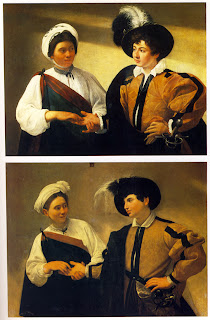 My continued focus on hands and feet brought out a comment from a daughter, the one with a Degree in History of Art, that most artists have found hands difficult.
My continued focus on hands and feet brought out a comment from a daughter, the one with a Degree in History of Art, that most artists have found hands difficult.
We then moved on to her pet subject of Rubens who was good at hands! We inevitably moved on to Caravaggio and searching through Giorgio Bonsanti’s book I found these pictures.
John B’s post about the first of these sprang to mind immediately and made me question the stories and “facts” surrounding these two paintings. Bonsanti has written on the subject ; “His lesson is not drawn from history but from life”.
He has made no analysis of the pictures. He talks about Caravaggio’s mission as a cutting edge artist being illustrated here. He has side stepped the subject matter and left it to a reference; Belori’s view, a writer that Bonsanti describes as highly critical of Caravaggio.
So I beg answers to a few questions:
 Can you, on oath see a ring here?
Can you, on oath see a ring here?
 Does she look like a Gypsy Fortune teller?
Does she look like a Gypsy Fortune teller?
http://www.kfki.hu/~/arthp/html/c/caravagg/02/11fortu.html
http://www.students.sbc.edu/mckinney03/gmm/caravaggio.htm



According to the site http://www.answers.com/topic/the-fortune-teller
The above picture of your posing is the second version of the painting, and the picture underneath it is the first version. In-between are not ten, but one years according to this site; however it says that this period is disputed among the scholars. I also believe it’s logical because the first version (above) is far more attractive and expressive, and suited for the intention to picture innocence and/or seduction, than the picture below. One can also notice that in the above painting the hands are very skilfully painted, far more than in the below painting. No, I don’t see any ring, it’s far better to assume that following the “relevant” handlines by the girl is at the same time an erotic stimulation, and the boy doesn’t seem insensitive to it. I think she is a gypsy girl because her “turban” also appears on the other, manierist picture you show. I think suggesting she is stealing a ring is innecessary & redundant and not sustained by what the painting shows. The stealing-act would have disturbed the painting’s message and the artist’s intention I think. The facial expression of the girl doesn’t support the ring-theory either.
I enjoyed this painting-watching, I love expecially the second painting and would like to swop the second for the vanished painting that contemporaries wrote about and must have existed.
Thanks, Robert!
It could also be that C. was a businessman (he had to keep his painting business going on) and left the choice of whether or not a ring was being stolen to “the eyes of the beholder”, thus pleasing both interpretations. In those times many people had other ideas about prejudice and discrimination than nowadays (although….)
Those two paintings make a fascinating contrast, don’t they ?
If Caravaggio really made them both — and made them a year apart — it’s a fine example of his ability to improve his work — dramatically, and over a short period of time.
He’s almost like an artilleryman — his first shot finds the range — his second shot demolishes the target.
(and I can’t see a ring, either. I wonder how that story got started)
I think they look related.
I dont see any rings.
That one girl–I would say gypsy with made powers.
I have a hand and cigarette posed picture that I use as an icon and used it just the other day if you want to see it. Its from a famous calender line where a woman takes old pictures and puts new captions with them.
I look forward to seeing someof those pics.
I chose the hand picture becasuse I did think it was elegant and sophisticated in its own daring way, although I dont smoke. Sometimes I just pretend to have that daring attitude, or that how should I say it…that fabulous hollywood starlet from the 1930s attitude, if that makes sense.